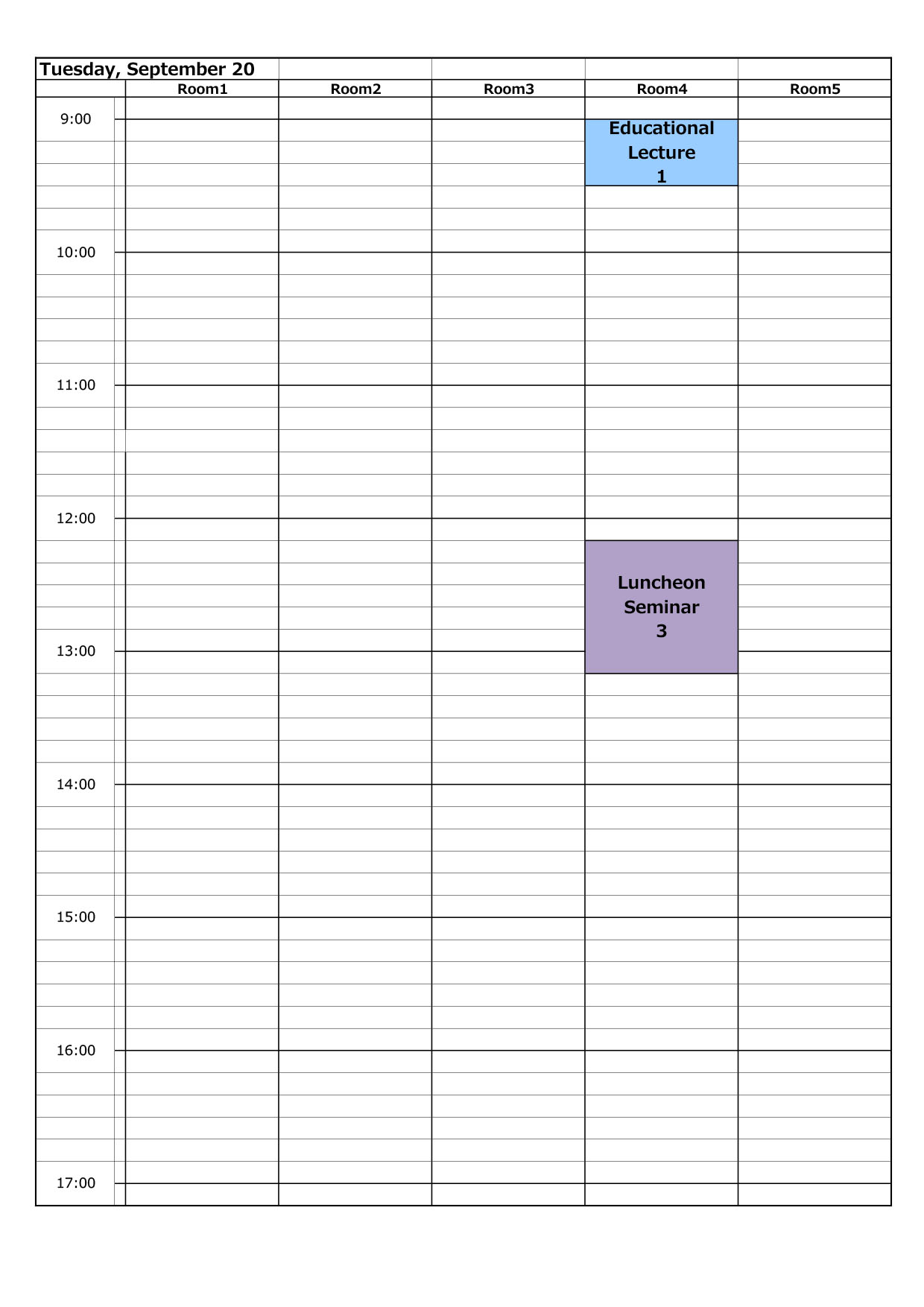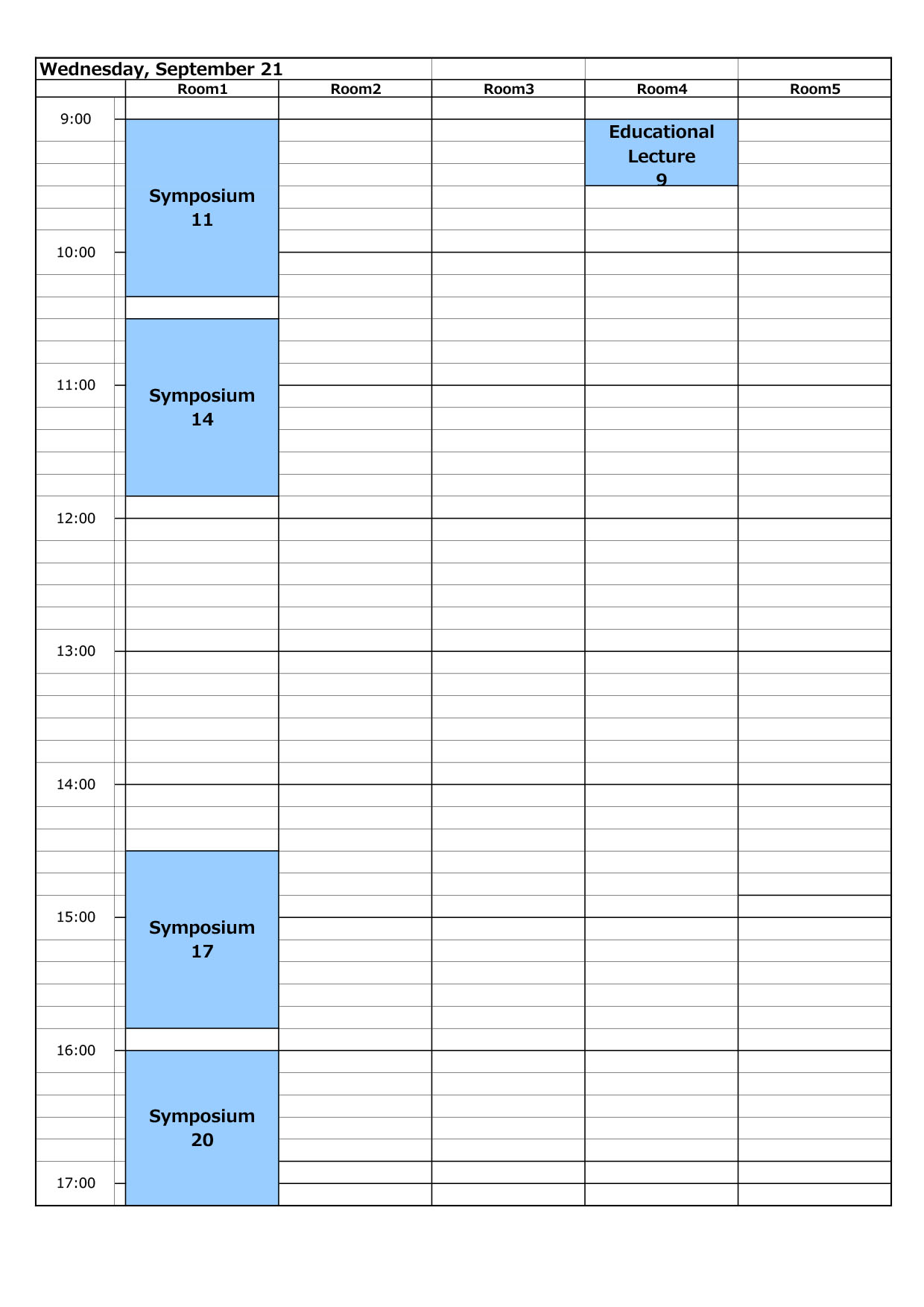Program

Tuesday, September 20
Educational Lecture 1
9:00〜9:30 Room 4
Chairperson
Hiroshi Shigeto (Kyushu University)
Speaker
Farhad Sahebkar (Jazz Pharmaceuticals, Inc)
Cannabidio(l CBD)clinical development update:supported by 5 c ompleted double-blind andomized placebo-controlled trials(RCTs)
Luncheon Seminar 3
12:15〜13:15 Room 4
Chairperson
Hiroaki Tomita (Tohoku University)
Speaker
Reyko Tech (Neuroscan / Compumedics Limited in Germany)
CURRY Neuroimaging Software:Advanced Multi-Modal integration for EEG and MEG data analysis
Speaker2
Simon Vogrin (St Vincentʼs Hospital Melbourne)
The Power of one - a reimagining of exploring epilepsy multimodal presurgical assessment
Co-organizer: Fukuda Denshi Co., Ltd.

Wednesday, September 21
Educational Lecture 9
9:00〜9:30 Room 4
Chairperson
Masaki Iwasaki (National Center for Psychiatry and Neurology)
Speaker
Richard C. Burgess (Cleveland Clinic Neurological Institute)
The important role of MEG in epilepsy care
Symposium 11
9:00〜10:15 Room 1
KES-JES Joint Session: 〜How can we contribute to the global epilepsy care?〜
KES-JES Joint Session has shared the wide range of common concerns from basic research to clinical care in last 15 years between us and far beyond. Before COVID-19 pandemic, the global approach of epilepsy care has been led by the strong collaboration among WHO, ILAE and IBE. Once IGAP (Intersectoral global action plan on epilepsy and other neurological disorders)shall be approved by WHA in 2022, global epilepsy care would move forward and also individualized by MOH of each country. In the KES JES Joint Session in 2022, we could share the current experience and contribution to the global and individualized epilepsy care among us
Chairperson
Akio Ikeda (Kyoto University)
Ki Joong Kim (Seoul National University Children’s Hospital)
Speaker
Yosuke Kakisaka (Tohoku University Hospital)
Teleconference-based pre-primer epilepsy education for Indonesia
Eunik Son (Addis Ababa University Hospital)
Epilepsy care and treatment gap in Ethiopia―An innovative model in Ethiopia―
Koji Iida (Hiroshima University / Hiroshima University Hospital)
How can we contribute to epilepsy care in Nepal?
Seung Bong Hong (National Epilepsy Care Center / Sungkyunkwan University)
Symposium 14
10:30〜11:45 Room 1
How can we overcome epilepsy treatment gaps in Asia and Oceania?
Chairperson
Kosuke Kanemoto (Aichi Medical University)
Hsiang-yu Yu (Taipei Veterans General Hospital)
Speaker
Marc Laurence L. Fernandez (Philippine General Hospital)
Epilepsy treatment gaps in the Philippines
Zainal Muttaqin (Diponegoro University / Dr. Kariadi Hospital)
Epilepsy surgery awareness in Indonesia
Sang-Ahm Lee (University of Ulsan College of Medicine)
Does the new Korean term for epilepsy reduce the stigma for Korean adults with epilepsy?
Hsiang-yu Yu (Taipei Veterans General Hospital)
Epilepsy awareness activity in Taiwan
Nicholas Lawn (Western Australian Adult Epilepsy Service)
Telemedicine of epilepsy in Australia
Symposium 17
14:30〜15:45 Room 1
Wide band EEG for daily use
In the latest new era of digital EEG, so called wide band EEG ranging from extremely slow activity (direct current, infraslow)to extremely fast activity(ripple or fast ripple)has been investigated to define the epileptogenic zone as possible biomarkers before epilepsy surgery by invasive EEG. Its clinical application has expanded into scalp EEG in epilepsy and critical care EEG. In this symposium, we share the basic knowledge and information how to record, analyze and interpret wide band EEG in daily clinical practice of scalp EEG.
Chairperson
Akio Ikeda (Kyoto University)
Kyoko Kanazawa (National Center of Neurology and Psychiatry)
Speaker
Akio Ikeda (Kyoto University)
Introduction to wide-band EEG
Masao Matsuhashi (Kyoto University)
How to analyze the wide band EEG
Shunsuke Kajikawa (Kyoto University / Kyoto Medical Center)
Case presentation:Intracranial EEG
Katsuhiro Kobayashi (Okayama University)
Case Presentation:Scalp EEG
Symposium 20
16:00〜17:15 Room 1
Do you REALLY know how to take history and how to read EEG for seizures?
Chairperson
Nobukazu Nakasato (Tohoku University Hospital)
Speaker
Sandor Beniczky (Aarhus University Hospital / Danish Epilepsy Centre)
A pragmatic algorithm to classify seizures without EEG
Stefan Rampp (University Hospital Erlangen)
Source-based, but not sensor-based, EEG reading for focal epilepsy

Thursday, September 22
Educational Lecture 17
9:00〜9:30 Room 4
Chairperson
Mayu Fujikawa (Tohoku University Hospital)
Speaker
Bruce Hermann (University of Wisconsin Madison)
Characterizing Cognitive and Behavior Phenotypes in Epilepsy
Educational Lecture 18
9:45〜10:15 Room 4
Chairperson
Mayu Fujikawa (Tohoku University Hospital)
Speaker
Carrie R. McDonald (University of California San Diego)
Determining the neural basis of cognitive phenotypes in epilepsy

